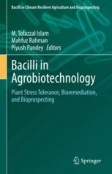Search
Search Results
-
Hydrocarbon selectivity enhancement through catalytic fast co-pyrolysis of almond shell and plastic blends
BackgroundThe aim of this article is to explore possible pathways for the synergistic optimization of bio-oil by the catalytic fast co-pyrolysis of...

-
Agronomic Crop Responses and Tolerance to Polycyclic Aromatic Hydrocarbon Toxicity
Polycyclic aromatic hydrocarbons (PAHs) are made up of only carbon and hydrogen and composed of two or more fused benzene cycles. It includes a large...
-
Biodegradation of a complex hydrocarbon mixture and biosurfactant production by Burkholderia thailandensis E264 and an adapted microbial consortium
Bioremediation is considered to be an effective treatment for hydrocarbon removal from polluted soils. However, the effectiveness of this treatment...

-
Effect of Hydrocarbon Pollution on the Fungal Communities of the Littoral Sediments of the White and Barents Seas
AbstractThe effect of hydrocarbon pollution on the fungal communities of littoral sediments of the cold-water White and Barents seas was...

-
Aryl hydrocarbon receptor–kynurenine axis promotes oncogenic activity in BCP-ALL
B-cell precursor acute lymphoblastic leukemia (BCP-ALL), the most common childhood cancer, originates from lymphoid precursor cells in bone marrow...

-
Identifying bioaugmentation candidates for bioremediation of polycyclic aromatic hydrocarbons in contaminated estuarine sediment of the Elizabeth River, VA, USA
AbstractEstuarine sediments near former creosoting facilities along the Elizabeth River (Virginia, USA) are contaminated by polycyclic aromatic...

-
Metagenomics-metabolomics analysis of microbial function and metabolism in petroleum-contaminated soil
Contamination of soil by petroleum is becoming increasingly serious in the world today. However, the research on gene functional characteristics,...

-
Evaluation of in situ biosurfactant production by inoculum of P. putida and nutrient addition for the removal of polycyclic aromatic hydrocarbons from aged oil-polluted soil
This work aimed to conduct a laboratory study to evaluate the use of Pseudomonas putida CB-100 and nutrient addition for the removal of PAHs from an...

-
Uremic toxins mediate kidney diseases: the role of aryl hydrocarbon receptor
Aryl hydrocarbon receptor (AhR) was originally identified as an environmental sensor that responds to pollutants. Subsequent research has revealed...

-
Genome-resolved analyses show an extensive diversification in key aerobic hydrocarbon-degrading enzymes across bacteria and archaea
BackgroundHydrocarbons (HCs) are organic compounds composed solely of carbon and hydrogen that are mainly accumulated in oil reservoirs. As the...

-
Implications of xenobiotic-response element(s) and aryl hydrocarbon receptor in health and diseases
The effect of air pollution on public health is severely detrimental. In humans; the physiological response against pollutants is mainly elicited via...

-
Ability of marine-derived fungi isolated from polluted saline environment for enzymatic hydrocarbon remediation
Marine-derived fungi have attracted much attention due to their ability to present a new biosynthetic diversity. About 50 fungal isolates were...

-
Bacterial crude oil and polyaromatic hydrocarbon degraders from Kazakh oil fields as barley growth support
AbstractBacterial strains of the genera Arthrobacter , Bacillus , Dietzia , Kocuria , and Micrococcus were isolated from oil-contaminated soils of the...

-
Nondesulfurizing benzothiophene biotransformation to hetero and homodimeric ortho-substituted diaryl disulfides by the model PAH-degrading Sphingobium barthaii
Understanding the biotransformation mechanisms of toxic sulfur-containing polycyclic aromatic hydrocarbon (PASH) pollutants such as benzothiophene...

-
Role in aromatic metabolites biodegradation and adverse implication of denitrifying microbiota in kitchen waste composting
BackgroundUnderstanding the functional diversity, composition, and dynamics of microbiome is critical for quality in composting. Denitrifying...

-
Genomic and transcriptomic perspectives on mycoremediation of polycyclic aromatic hydrocarbons
Mycoremediation holds great potential in remedying toxic environments contaminated with polyaromatic organic pollutants. To harness the natural...

-
Bacillus Species and Their Invaluable Roles in Petroleum Hydrocarbon Bioremediation
Exploration, production activities as well as improper waste disposal practices have led to major contamination of both aquatic and terrestrial...
-
Airborne particulate matter (PM10) induces cell invasion through Aryl Hydrocarbon Receptor and Activator Protein 1 (AP-1) pathway deregulation in A549 lung epithelial cells
BackgroundParticulate matter with an aerodynamic size ≤ 10 μm (PM 10 ) is a risk factor for lung cancer development, mainly because some components...

-
Hydrocarbon-degrading bacteria in Colombia: systematic review
Petroleum industry activities worldwide have caused pollution and resulted in environmental degradation. Microorganisms with the potential to reduce...

-
Polycyclic aromatic compounds in plants and peat in the peatlands of the European part of Russian Arctic
AimTo investigate PAH accumulation in the peat of the swampy hollows in the series of European Arctic tundra sites and to evaluate the effect of PAH...

